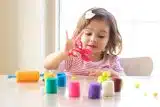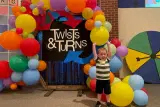Vestibular, what – what??
Kids
 Posted by: Rebecca Bazzoni 2 years ago
Posted by: Rebecca Bazzoni 2 years ago

The vestibular system helps with balance and movement and is centered in the inner ear. Each of us has vestibular organs located deep inside our ears. When we move our heads, the fluid in these organs moves and shifts, constantly providing us with information about the position of our heads and bodies in space, also known as spatial awareness.
This sense allows us to maintain our balance and to experience gravitational security: confidence that we can maintain a position without falling. The vestibular system allows us to move smoothly and efficiently. It also works right alongside all of our other sensory systems, helping us use our eyes effectively and process sounds in our environment. Overall, vestibular processing helps us feel confident moving and interacting with our surroundings.
WHAT DOES A HEALTHY VESTIBULAR SYSTEM LOOK LIKE?
When our vestibular sense is fully functioning, we are secure and organized enough in our bodies to be able to attend and respond to all of the other senses we encounter daily. A child with a well-developed vestibular sense feels confident and safe during movement activities, even if his feet are off the ground. He/she is able to start and stop movement activities calmly and with control. He/she is comfortable with climbing, swinging, somersaulting, and jumping – knowing that their body will adapt and that they will be able to maintain their balance and keep themselves from falling or getting inquired.
SIGNS OF A TROUBLED VESTIBULAR SYSTEM
A healthy vestibular system is central to the integration of the other sensory systems. When a child’s vestibular system is not functioning correctly, he may be under responsive or overly sensitive to movement. He may either need to move constantly to feel satisfied or he may be fearful of movement because it makes him feel insecure and unbalanced. He may move in an uncoordinated, clumsy manner, bumping into things, falling, and never fully walking or sitting in an upright manner. This is the child that slouches at his desk or is constantly being directed to “stand up straight” or “quit leaning on the wall!” He may appear weak or “floppy.”
As a result, he might have difficulty coordinating and planning motor tasks such as jumping jacks, skipping, catching a ball with two hands, or reaching across the center of his body (crossing midline), or even coordinating movements of the mouth, resulting in difficulty with speech production.
Vision is closely related to the vestibular system. When we feel balanced and centered, our eyes can move smoothly and steadily and are able to focus, track, and discriminate between objects in our environment. Difficulty with tasks that require the eyes to move left to right (e.g. reading) or up and down repeatedly (e.g. copying information from the board) may be signs of a disrupted vestibular system.
If your child exhibits any symptoms of vestibular processing difficulties, seek advice from your physician and/or an occupational therapist who can guide your child in a safe, secure manner to develop and adapt this important sensory function.
ACTIVITIES TO PROMOTE DEVELOPMENT OF THE VESTIBULAR SYSTEM
Most children develop a strong vestibular sense simply through engaging in everyday play activities that allow for exploration and movement. There are many activities that can help promote the development of a healthy vestibular system. Here are some of our favorites:
- Swings are great for encouraging all sorts of movement, front to back, side to side, circular. Let kids go at their own speed: fast and high, or slow and low. It’s all great vestibular experience! Not at the park? Try a blanket or sheet held by two adults for a makeshift swing!
- Slides are also beneficial for providing fast movement.
- Hanging upside down from playground equipment
- Rocking! Fast, slow, or to the rhythm of your favorite song!
- Spinning! Office-style swivel chairs are perfect. Or try a sit and spin toy, log rolling across floors or down hills, somersaults, or cartwheels. Other ways to spin: tire swings, scooter boards, and merry go rounds.
- Jumping! On a trampoline, up/down off curbs or other surfaces, jumping jacks, jump rope, hopscotch. Bouncing on a large inflatable ball, such as an exercise ball.
- Running! Set up an obstacle course with options to go over/under, climb up/down, run backwards from one point to another, etc. Try a game of hide and seek or tag!
- Balance activities: walk on the curb or a balance beam, walk across the bed without falling, stand on a half-inflated beach ball, walk while balancing an item on your head, play Twister, or try some fun kids’ yoga poses
- Visual motor activities that require balance and movement: dribbling a ball, catching a ball, flashlight tag.
Credit: Theinspiredtreehouse.com and yourkidstable.com
Categories:
You May Be Interested In:

Why Pre-Writing Skills Matter and How to Foster Them in Young Children
4 days ago by Rebecca Bazzoni

Accessible Holiday Celebrations
8 months ago by Rebecca Bazzoni

Meet Greyson
1 year ago by Rebecca Bazzoni

3 Enriching Summer Activities to Encourage Language Development
1 year ago by Rebecca Bazzoni

